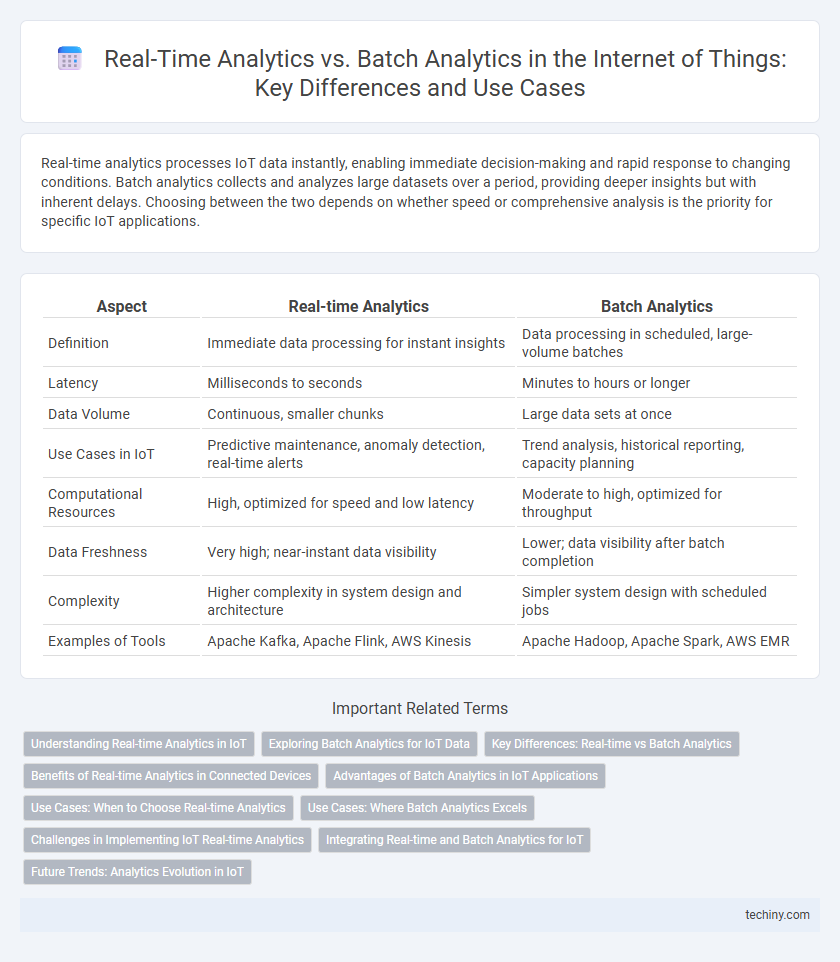Real-time analytics processes IoT data instantly, enabling immediate decision-making and rapid response to changing conditions. Batch analytics collects and analyzes large datasets over a period, providing deeper insights but with inherent delays. Choosing between the two depends on whether speed or comprehensive analysis is the priority for specific IoT applications.
Table of Comparison
| Aspect | Real-time Analytics | Batch Analytics |
|---|---|---|
| Definition | Immediate data processing for instant insights | Data processing in scheduled, large-volume batches |
| Latency | Milliseconds to seconds | Minutes to hours or longer |
| Data Volume | Continuous, smaller chunks | Large data sets at once |
| Use Cases in IoT | Predictive maintenance, anomaly detection, real-time alerts | Trend analysis, historical reporting, capacity planning |
| Computational Resources | High, optimized for speed and low latency | Moderate to high, optimized for throughput |
| Data Freshness | Very high; near-instant data visibility | Lower; data visibility after batch completion |
| Complexity | Higher complexity in system design and architecture | Simpler system design with scheduled jobs |
| Examples of Tools | Apache Kafka, Apache Flink, AWS Kinesis | Apache Hadoop, Apache Spark, AWS EMR |
Understanding Real-time Analytics in IoT
Real-time analytics in IoT processes data streams instantly from connected devices to enable immediate decision-making and rapid response to events. This approach leverages edge computing and AI algorithms to analyze sensor data on the fly, enhancing operational efficiency and predictive maintenance. Compared to batch analytics, which aggregates data over time for retrospective insights, real-time analytics provides critical, time-sensitive intelligence crucial for applications like smart cities and autonomous vehicles.
Exploring Batch Analytics for IoT Data
Batch analytics processes large volumes of IoT data collected over extended periods, enabling comprehensive trend analysis and historical insights crucial for optimizing device performance and predictive maintenance. This method leverages distributed computing frameworks like Apache Hadoop and Spark to efficiently handle massive datasets generated by diverse IoT sensors and devices. Although real-time analytics provides immediate data processing, batch analytics facilitates deep learning and model training by analyzing aggregated data, driving strategic decision-making in IoT ecosystems.
Key Differences: Real-time vs Batch Analytics
Real-time analytics processes IoT data instantly as it is generated, enabling immediate insights and rapid decision-making crucial for applications like predictive maintenance and anomaly detection. Batch analytics, in contrast, aggregates large volumes of IoT data over a period before processing, which suits historical trend analysis and comprehensive reporting. The key differences lie in latency, data freshness, and responsiveness, with real-time analytics prioritizing low latency and continuous data streams, while batch analytics emphasizes completeness and depth of analysis.
Benefits of Real-time Analytics in Connected Devices
Real-time analytics in connected devices enables instantaneous decision-making by processing data as it is generated, which enhances operational efficiency and responsiveness. This approach improves predictive maintenance by identifying anomalies immediately, reducing downtime and lowering costs. Continuous monitoring through real-time analytics also optimizes user experience and energy consumption in Internet of Things ecosystems.
Advantages of Batch Analytics in IoT Applications
Batch analytics in IoT applications enables efficient processing of large volumes of sensor data, reducing computational resource demands compared to real-time analytics. By aggregating data over time, batch processing enhances data accuracy and consistency, making it ideal for historical trend analysis and predictive maintenance. This approach helps businesses optimize operational costs and supports strategic decision-making with comprehensive datasets.
Use Cases: When to Choose Real-time Analytics
Real-time analytics is essential for Internet of Things (IoT) applications requiring immediate data processing, such as predictive maintenance in manufacturing, autonomous vehicle navigation, and smart grid management. These use cases depend on instant insights to trigger automated responses and prevent failures or hazards. Opt for real-time analytics when latency and rapid decision-making directly impact operational efficiency and safety.
Use Cases: Where Batch Analytics Excels
Batch analytics excels in scenarios requiring analysis of large historical datasets, such as fraud detection over months of transaction data, or trend analysis in smart energy grids to optimize usage patterns. It enables complex computations that are not time-sensitive, like periodic reporting for supply chain management or anomaly detection in IoT sensor data over extended periods. These use cases benefit from batch processing's ability to handle high data volumes efficiently with delayed processing tolerances.
Challenges in Implementing IoT Real-time Analytics
Implementing IoT real-time analytics faces challenges such as high data velocity requiring robust stream processing systems and the need for low-latency data ingestion architectures to provide immediate insights. Scalability issues arise due to the exponential growth of connected IoT devices generating massive volumes of data, demanding efficient resource management and distributed computing frameworks. Ensuring data accuracy and security in real-time environments compounds complexity, necessitating advanced anomaly detection and encrypted data transmission protocols.
Integrating Real-time and Batch Analytics for IoT
Integrating real-time and batch analytics in IoT enables continuous data processing, leveraging real-time systems for immediate event detection while utilizing batch analytics for comprehensive historical insights. This hybrid approach optimizes decision-making by processing streaming sensor data instantly and performing in-depth analysis on aggregated datasets, enhancing predictive maintenance and operational efficiency. Combining both analytics types supports scalable, flexible IoT architectures that address latency-sensitive and complex analytical requirements effectively.
Future Trends: Analytics Evolution in IoT
Real-time analytics in IoT enables instantaneous processing of streaming data from connected devices, facilitating proactive decision-making and immediate anomaly detection. Batch analytics processes large volumes of historical IoT data to uncover long-term patterns and optimize strategic operations. Future trends emphasize hybrid analytics models that integrate real-time and batch processing, leveraging edge computing and AI to enhance scalability and responsiveness in IoT ecosystems.
Real-time analytics vs Batch analytics Infographic

 techiny.com
techiny.com